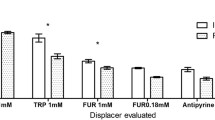Abstract
Conventional dialysis cells were used in initial attempts to determine the binding characteristics of oxaprozin (4,5-diphenyl-2-oxazoleproplonic acid, Wy-21,743). Equilibration required dialysis times up to 22 hours at 37°C resulting in deterioration of plasma proteins, which in turn leads to highly variable binding values. In contrast, dialysis with Dianorm™ cells requires less than 4 hours to reach equillibrium. The configuration of the cell optimizes the contact between the solutes and the membrane and allows for a more efficient mixing and exchanging of the solute. The percentage of unbound drug was linearly related to total drug in human plasma samples to which oxaprozin in clinically relevant concentrations (55–405 μg/ml) had been added. Likewise, a linear relationship between total drug concentration and the percentage unbound was observed in specimens from a pharmacokinetic study in healthy volunteers. Clearance of total oxaprozin from plasma correlated with the percentage unbound drug. Thus the higher clearance observed under steady-state conditions (where concentrations are higher than following single dose administration) was caused by a larger unbound fraction available to the elimination sites.
Similar content being viewed by others
References
K. Brown, J.F. Cavalla, D. Green andA.B. Wilson,Diaryloxazole and diarylthiazolealkanoic acids: Two novel series of non-steroidal anti-inflammatory agents, Nature219, 164 (1968).
M.E. Rosenthale, A.J. Begany, A. Dervinis, J.L. Malis, D.A. Shriver, L.J. Datko andM.I. Gluckman,Anti-inflammatory properties of 4,5-diphenyl-2-oxazolepropionic acid (oxaprozin), Agents and Actions4, 151–159 (1974).
I.M. Ballard, B.R. Walker andJ.A. Gold,A multicenter comparison of oxaprozin and aspirin 23 (1), 108 (1978).
F.W. Janssen, W.J. Jusko, S.T. Chiang, S.K. Kirkman, P.J. Southgate, A.J. Coleman andH.W. Ruelius,Metabolism and kinetics of oxaprozin in normal subjects, Clin. Pharmac. Ther.27 (1), 352–362 (1980).
J.J. Vallner,Binding of drugs by albumin and plasma protein, J. Pharm. Sci.66 (4), 447–465 (1977).
M. Meyer andD. Guttman,The binding of drugs by plasma proteins, J. Pharm. Sci.57 (6), 895–918 (1968).
A. Yacobi, J. Udall andG. Levy,Serum protein binding as a determinant of warfarin body clearance and anticoagulant effect, Clin. Pharmac. Ther.19 (5), 552–558 (1976).
Manual of Clinical Laboratory Procedures, pp. 78–79, 2nd edn (EdsW.R. Faulker andJ.W. King) The Chemical Rubber Co. Cleveland, Ohio 1970.
F.W. Janssen, S.K. Kirkman, J.A. Knowles andH.W. Ruelius,Disposition of 4,5-diphenyl-2-oxazolepropionic acid (oxaprozin) in beagle dogs and rhesus monkeys, Drug Metab. Disp.6 (4), 465–475 (1978).
Author information
Authors and Affiliations
Rights and permissions
About this article
Cite this article
Homon, C.A., Fluck, E.R., Janssen, F.W. et al. Protein binding and clearance of oxaprozin, a highly bound anti-inflammatory agent. Agents and Actions 12, 211–215 (1982). https://doi.org/10.1007/BF01965148
Received:
Issue Date:
DOI: https://doi.org/10.1007/BF01965148




